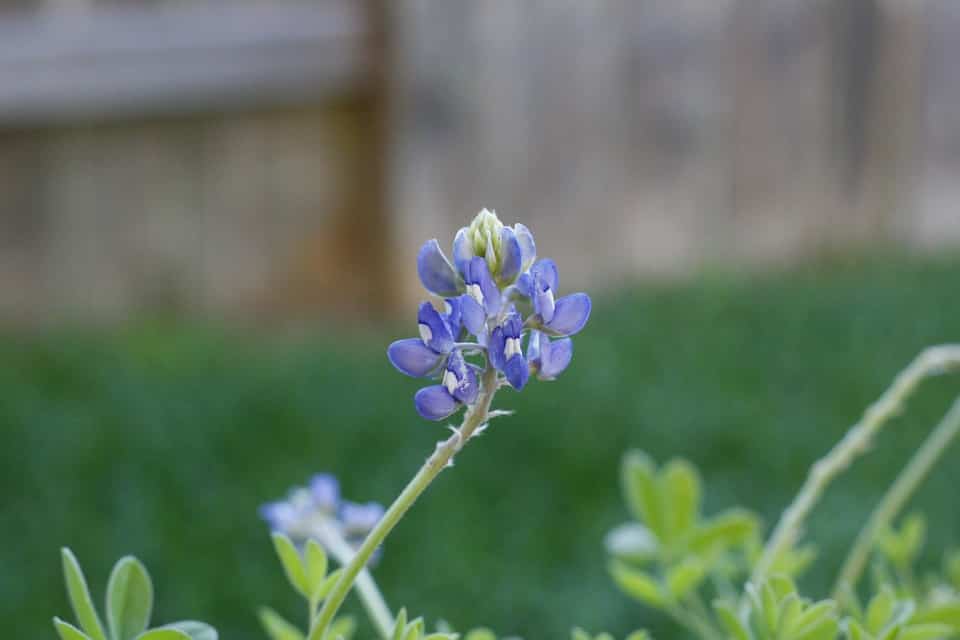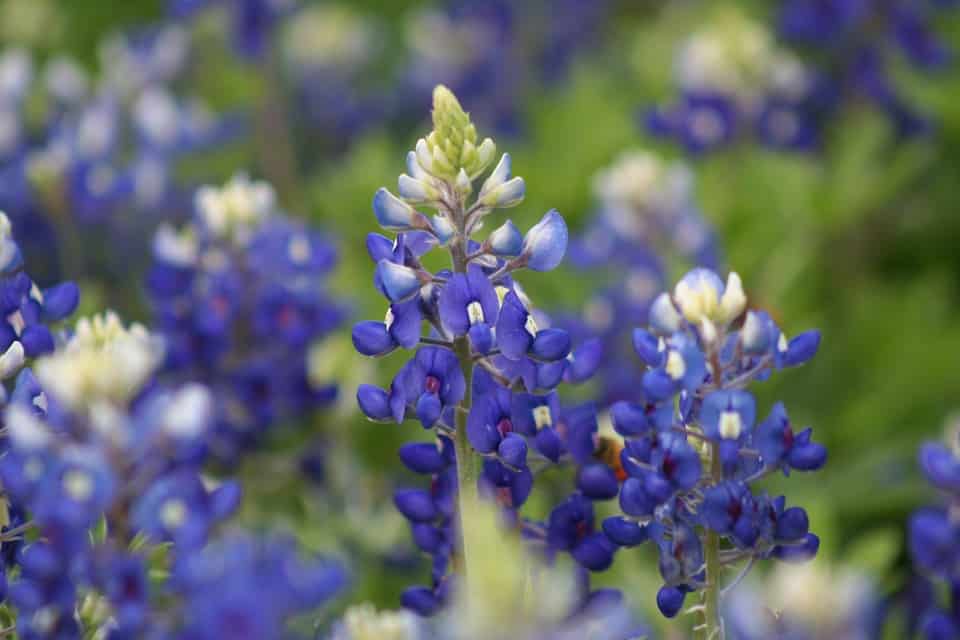Botanically known as Lupinus Texensis, bluebonnets are plants with blue-colored flowers, and these flowers are also topped with white color. These flowers, when planted create a visual treat for the eyes. If you want to get some of these appealing and eye-catching flowers in your home garden, you must learn how to plant bluebonnets in a pot.

Blue Bonnet Plants
Bluebonnets have been cultivated for a long time. It has been cultivated in most parts of the inhabited world. This plant is known for its ornamental value. Bluebonnets are native to the state of Texas in the United States of America. It is also the official flower of the State of Texas.
These flowers take over all the hills and empty spaces of Texas in the spring season. Also, it is encouraged to grow bluebonnets being the official flower. It has blue flowers which are topped with white color.
It would surely give you a pleasing site when planted in a row or in a bunch. These plants are also easy to take care of, so once planted they will be easy to grow. You have to keep one thing in mind, these bluebonnets are annual plants. For the next year, you would have to plant from start.
Why Plant Blue Bonnets?
First of all, this plant has great ornamental value. Many people plant bluebonnets even though there are efforts involved every year. These plants are a fantastic addition to the garden. If you plant it in a container, still it will be a showstopper.
Characteristics of Blue Bonnets
The care of these bluebonnets is quite easy. These plants are drought tolerant. They require just a mere basic requirement to be fulfilled, to grow and bloom steadily. This plant is good to plant in United States hardiness zones from 7 to 10.
Besides adding decoration to the garden, hallway, front of the house, or indoors, this plant produces seeds that can be planted and repropagated. Most of the time annual plants fail to provide good seeds, but here in the case of bluebonnets, you will be able to get a sizable number of seeds that you can distribute and plant later on.
How to Grow Blue Bonnets in Pots
These plants can be propagated from the stems or cuttings. But the standard method of growing bluebonnets is to grow them from seeds. This ensures more successful germination and success in terms of the growth of plants.
Can you grow bluebonnets indoors?
As native Texas people are habitual of seeing bluebonnets everywhere in the open areas, and even in the gardens. These plants can also be planted indoors in containers. You just need to get the flower’s seed and the pot in the right space and time. Then you are good to go.
Getting the Seeds of Blue Bonnets
You can get the seeds of bluebonnets from any nursery or from the horticultural store. They can also be bought online The seeds are available in the winter season. The timing is important, so you need to get the seeds in the late fall. Because the seeds start sprouting in the early spring season after the last frost is over.
Checking and Cleaning the Seeds
Make sure you check the seeds thoroughly. Because it can contain weed seeds, which you would not like to add to your container. Checking and cleaning the seeds also makes sure that the seed is good to sow, and that there are no hurdles (like a hurt seed, etc) and impurities in it.
Making the Seeds Ready to be Sowed
Bluebonnet seeds are hard. They need to be broken or you can say weakened in order to germinate. Because they have a hard coat on them. There are many methods of scarification which are used to make the seeds of bluebonnets able to germinate.
You can use sandpaper to nick the coats of the seeds. On the other hand, you can put the seeds in boiling water, soak them for a few hours, and then leave them overnight. You can also use the knife to nick the coats so that the inner part of the seed is visible. Also, it can be rubbed against the sandpaper to get the same result.
Scarification is necessary otherwise, the seed can take years to grow.
Selection of Container to Plant Blue Bonnets
Although the bluebonnets can be grown in small containers, a large container is required to create a real sense of visual pleasure. The bunch of flowers will get you the fruit of your efforts. A 3-to-5-gallon-sized container will work best. Use a container that has plenty of drainage holes.
Good drainage will make sure the smooth growth of the plant. It will also help in avoiding many problems. Place the container in a sunny place. The bluebonnet plant will grow well in full-day sunlight.
Selection of Soil to Plant Blue Bonnets
Select any gardening soil to fill the container. Add the mixture of organic compost in a small quantity. Bluebonnets can perform and grow in little fertile soil also. Make sure the soil is slightly moistened before sowing the seeds. Check the soil for weeds also.
Sowing the Blue Bonnets Seeds
Now the container has been selected, and suitable soil has been filled in it, now we can sow the seeds. Try to sow the seeds in the fall because bluebonnets do best when sown at that time. In the period of fall, the seeds complete the dormancy period and germinate in the early spring.
Sow only three seeds in the area of six square inches of soil. Allow the seeds to go down in the soil about ¼ inches deep. Cover the seeds with soil with a thin layer. Keep the soil of the pot moistened throughout the winter so that the bluebonnets can germinate successfully.
Actually, if the sown seeds are left dried it can result in no germination. So, keep the soil moistened, but not overwatered. It will result in a high rate of germination of seeds.
Bluebonnet seeds will start sprouting soon after the last frost has passed. Because of its timing, it will be one of the plants which will bloom first in spring.
Taking Care of Blue Bonnets Plants

The care of bluebonnets is quite an easy task. Now as the sprouts are up you need to follow some basic instructions and you are good to go.
Watering for Blue Bonnet Plants
Bluebonnet plants are drought tolerant. This means they can perform okay when there is a shortage of water. It performs much better when there is a quite good supply of water. So, keep the moisture intact. You can check the moisture with your fingers. If the upper layer of the soil is dry, then water it.
Don’t overwater the bluebonnet plants. It will stunt the growth of the plant. It might get the plant killed, and all your efforts might go in vain.
Sunlight Requirements for Blue Bonnet Plants
Bluebonnet plants grow well in full-day sunlight. If your container is not placed in a sunny place, then shift it in a day for at least 4 to 6 hours in the sunlight. Sunlight plays a key role in the growth of bluebonnet plants. Make sure the availability of sunlight.
Fertilizers Requirement for Blue Bonnet Plants
Not so many fertilizers are required for the bluebonnet plants. These plants can grow in moderately fertile soil. But you can add all-purpose fertilizers to the plants if they seem weak. It will result in a larger size of plants and good flowering.
Pests and Diseases for Blue Bonnets Plants
There are not so many pests or diseases that can affect the bluebonnets. That is why this plant is surviving and blooming on its own in the wild. There are some problems that a bluebonnet can face while growing indoors.
First of all, seeds and seedlings are more vulnerable. The seeds are small, and birds can eat them. Also, the tiny seedlings need care in starting to progress.
Pillbugs are one of the main predators of seeds and seedlings. It is also known as roly-poly or sow bugs. You can use any pesticide with the consultation of a nearby horticulturist.
Overwatering is one of the main problems. You need to keep in mind that overwatering might result in the killing of the plant. So, take good care of it.
These flowers are toxic if ingested by dogs. So, keep them away from your dog.
Harvesting Bluebonnets
If you want to grow the bluebonnets again, then collect their seeds. Gather the pods of the bluebonnets. Leave them to dry, and then get the pods open and remove the seeds. Collect the seeds and store them in a safe place.
Briefly, bluebonnets are not only a true ornamental addition to the garden (or indoor settings) but also a great flower plant to sow more and spread more.
You Might Like
References
https://homeguides.sfgate.com/plant-bluebonnets-container-22089.html
https://www.plantanswers.com/Articles/Bluebonnets-Grown-Outside-Of-The-State-Of-Texas.asp

